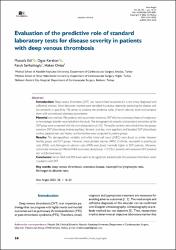Evaluation of the predictive role of standard laboratory tests for disease severity in patients with deep venous thrombosis
Özet
Introduction: Deep venous thrombosis (DVT) can result in fatal outcomes if it is not timely diagnosed and sufficiently treated. Some laboratory markers were identified in previous reports for predicting the disease with low sensitivity or specificity. We aimed to evaluate the predictive value of serum albumin levels and compare them with conventional laboratory parameters. Material and methods: Fifty patients with acute lower-extremity DVT who has no previous history of malignancy or hematologic disorder were included in the study. The demographical variables and standard biomarkers of the DVT group were compared with the normal population (n:50). Thereafter patients were divided into two groups extensive DVT (thrombosis involves popliteal, femoral, and iliac veins together) and localized DVT (thrombosis involves popliteal vein and below) and biomarkers were compared in patient groups. Results: The demographical variables and white blood cell count (WBC) were found as similar between healthy groups and DVT groups. However, mean platelet volume (MPV), D-Dimer, neutrophil to lymphocyte ratio (NLR), and fibrinogen to albumin ratio (FAR) were found markedly higher in DVT patients. Moreover, statistically incremental FAR and NLR levels were detected (p < 0.05) in patients with extensive DVT (involved iliac and femoral veins). Conclusion: Serum NLR and FAR levels seem to be significant predictors for the extensive thrombotic event in patients with DVT.
Kaynak
Acta AngiologicaCilt
28Sayı
1Bağlantı
https://www.scopus.com/record/display.uri?eid=2-s2.0-85130030619&origin=resultslist&sort=plf-f&src=s&nlo=&nlr=&nls=&sid=20c4fe371b9b908d4f7e419f791331ff&sot=aff&sdt=cl&cluster=scofreetoread%2c%22all%22%2ct&sl=72&s=AF-ID%28%22Alanya+Alaaddin+Keykubat+University%22+60198720%29+AND+SUBJAREA%28MEDI%29&relpos=54&citeCnt=1&searchTerm=https://hdl.handle.net/20.500.12868/2362
https://journals.viamedica.pl/acta_angiologica/article/view/84288


















